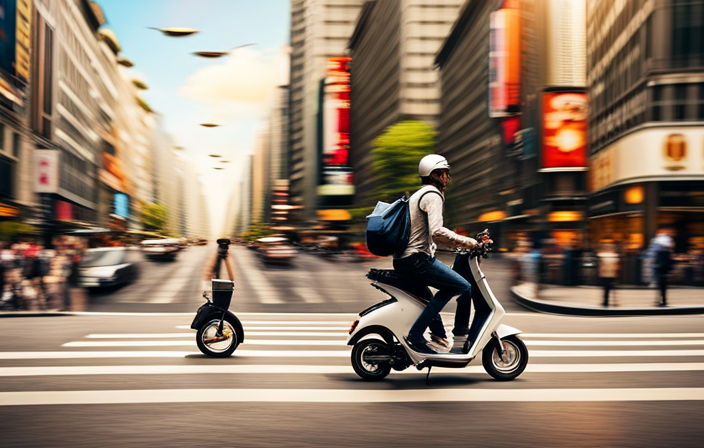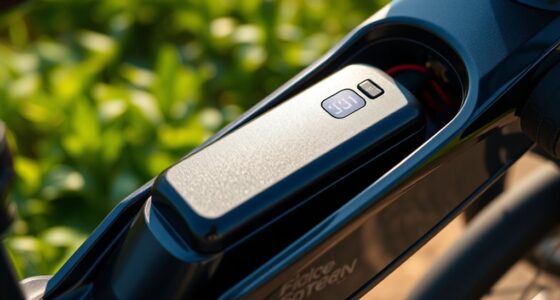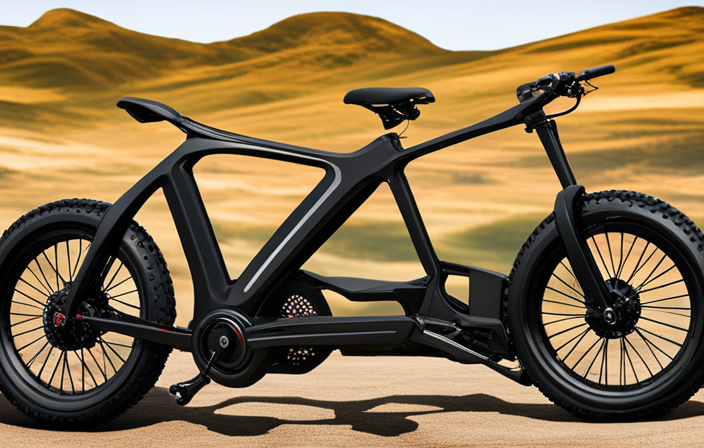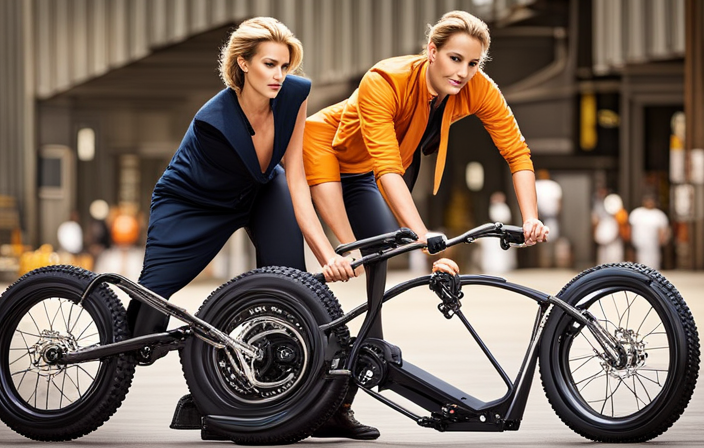Are you aware that electric bikes and electric scooters are gaining popularity as modes of transportation? Sales for both have been increasing, with electric bikes seeing a 145% rise in sales over the last year.
With this surge in popularity, it’s important to compare and contrast the two options to determine which is better for you. In this article, we will delve into the speed, range, comfort, cost, safety, terrain, licensing, and environmental impact of electric bikes and electric scooters to help you make an informed decision.
Key Takeaways
- Electric bikes have better off-road capabilities compared to electric scooters.
- Licensing requirements for electric bikes and electric scooters vary by jurisdiction.
- Electric bikes are quieter and have a more streamlined design, while electric scooters can be noisier.
- Electric bikes are ideal for those who enjoy cycling and want an alternative mode of transportation, while electric scooters are suitable for short trips and offer convenience.
Speed and Maneuverability
If you’re looking for speed and maneuverability, an electric scooter might be a better choice for you. When comparing speed, electric scooters tend to outperform electric bikes. Scooters can reach higher speeds, often reaching up to 30 miles per hour, whereas electric bikes typically have a speed limit of 20 miles per hour.
However, it’s important to consider that with increased speed comes a trade-off in stability. Electric bikes offer better stability due to their larger size and wider tires, making them more suitable for rough terrains or uneven surfaces.
When it comes to maneuverability, electric scooters have the upper hand. They are generally lighter and have a smaller turning radius, allowing for easier navigation through crowded streets or tight spaces.
However, electric bikes tend to have a longer range, providing a greater distance on a single charge. So, if you prioritize speed and maneuverability, an electric scooter is the way to go. But, if range and battery life are more important to you, keep reading to learn more.
Range and Battery Life
When it comes to range and battery life, you’ll find that electric bikes and electric scooters offer different levels of performance.
-
Electric bikes generally have a longer range compared to electric scooters. With an average range of 40-75 miles, electric bikes can take you on longer journeys without worrying about running out of battery. On the other hand, electric scooters typically have a range of 15-40 miles, making them more suitable for shorter commutes or running errands.
-
Charging time is another important factor to consider. Electric bikes usually take around 4-6 hours to fully charge, while electric scooters can be charged in as little as 2-3 hours. This means that if you need to charge your vehicle during the day, an electric scooter might be a more convenient option.
In terms of maintenance requirements, electric bikes and electric scooters are quite similar. Both require regular maintenance such as tire checks, brake inspections, and occasional battery replacements. However, scooters tend to have simpler designs and fewer components, making maintenance slightly easier.
Considering the differences in range, charging time, and maintenance requirements, it’s clear that electric bikes and electric scooters have their own advantages. Moving on to the next section about comfort and stability, you’ll find more factors to consider when choosing between the two.
Comfort and Stability
To determine which option is more comfortable and stable for you, consider your personal preferences and the terrain you’ll be riding on.
When it comes to comfort and stability, electric bikes and electric scooters each have their own advantages. Electric bikes typically offer a more comfortable ride due to their larger and more cushioned seats. They also provide better stability, especially when navigating uneven terrain or bumps on the road.
On the other hand, electric scooters are generally more compact and maneuverable, making them suitable for crowded urban areas. However, they may not provide the same level of comfort as electric bikes, especially on longer rides. It’s also important to note that both electric bikes and electric scooters can benefit from having suspension systems, which can further enhance comfort and stability.
Moving on to the next section about cost and affordability, it’s important to consider the financial aspect of choosing between an electric bike and an electric scooter.
Cost and Affordability
Considering the financial aspect, the cost and affordability of both electric bikes and electric scooters should be taken into account.
When comparing the initial investment, electric scooters tend to be more affordable than electric bikes. However, it is important to consider the long-term cost as well. Electric bikes generally have lower maintenance and repair costs, making them a cost-effective option in the long run.
Additionally, when it comes to financing options, electric bikes often have more availability compared to electric scooters. Many manufacturers and retailers offer financing plans, making it easier to spread out the cost over time. Moreover, government incentives such as tax credits and subsidies are often more accessible for electric bikes. These factors contribute to the overall affordability of electric bikes.
Transitioning into the subsequent section about safety features, it is crucial to consider the importance of ensuring a safe riding experience.
Safety Features
When considering safety features, electric bikes typically have an advantage over electric scooters. Electric bikes are commonly equipped with lights, reflectors, and larger frames, which enhance visibility and make them more noticeable on the road.
On the other hand, electric scooters may have smaller frames and fewer safety features, necessitating extra caution while riding.
Electric Bikes – Typically equipped with lights, reflectors, and larger frames for increased visibility
If you’re looking for increased visibility, electric bikes are a great option with their lights, reflectors, and larger frames. They offer a number of advantages in terms of safety features.
Here are three reasons why electric bikes are a safe choice:
-
Lights: Electric bikes are typically equipped with lights, ensuring that you can see and be seen, especially during low light conditions.
-
Reflectors: Along with lights, electric bikes also have reflectors, which further enhance visibility and make it easier for other road users to spot you.
-
Larger frames: Electric bikes often have larger frames compared to electric scooters, making them more visible to drivers and pedestrians.
With these safety features, electric bikes provide a safer riding experience, particularly in terms of visibility on the road. However, it’s important to note that electric scooters may have smaller frames and fewer safety features, requiring extra caution.
Electric Scooters – May have smaller frames and fewer safety features, requiring extra caution on the road
Despite their smaller frames and fewer safety features, electric scooters require extra caution on the road. Electric bikes, on the other hand, are typically equipped with lights, reflectors, and larger frames for increased visibility. This means that scooter riders need to be even more vigilant when navigating through traffic and sharing the road with other vehicles. According to data on road accidents involving electric scooters, lack of visibility and limited safety features contribute to a higher risk of accidents and injuries. It is crucial for scooter riders to prioritize road safety by wearing protective gear, following traffic rules, and practicing defensive driving. With these precautions in mind, riders can enjoy the convenience and efficiency of electric scooters while minimizing the risks.
Speaking of convenience, let’s now delve into the topic of storage and portability.
Storage and Portability
For storage and portability, an electric bike is easier to handle than an electric scooter. When it comes to portability considerations, electric bikes are often designed to be foldable, allowing for easy storage in small spaces like apartments or offices. They are also lightweight, making it convenient to carry them upstairs or onto public transportation. In terms of storage options, electric bikes typically have baskets or racks where you can store your belongings while riding. On the other hand, electric scooters may not have as many storage options and are bulkier to handle when not in use. To compare the two options more comprehensively, consider the table below:
| Electric Bikes | Electric Scooters | |
|---|---|---|
| Portability | Foldable and lightweight | Bulkier and less portable |
| Storage Options | Baskets or racks available | Limited storage options |
When it comes to terrain and versatility, electric bikes offer a wider range of options compared to electric scooters.
Terrain and Versatility
When it comes to different types of terrain and the ability to adapt, electric bikes offer more versatility than electric scooters.
Electric bikes are designed to handle various terrain types, including off-road capabilities. With their sturdy frames, wider tires, and powerful motors, electric bikes can navigate through rough terrains such as gravel, dirt, and grass with ease. Whether you’re going on a mountain trail or exploring a countryside path, an electric bike can handle it all.
On the other hand, electric scooters are more limited in their off-road capabilities and are better suited for smooth surfaces like city streets and sidewalks. So if you’re someone who enjoys exploring different terrains and wants the freedom to ride off the beaten path, an electric bike would be the better choice.
Moving on to licensing and regulations, it’s important to consider the legal requirements when riding these vehicles.
Licensing and Regulations
To ride either vehicle legally, you’ll need to familiarize yourself with the licensing and regulations in your area. Licensing requirements for electric bikes and electric scooters vary depending on the jurisdiction. In some places, electric bikes are treated the same as regular bicycles and do not require a license. However, in other areas, you may need to obtain a specific license or permit to ride an electric bike.
On the other hand, electric scooters usually require some form of license or registration, similar to motorcycles or cars. Enforcement measures for licensing violations also differ across regions. Some places have strict enforcement and penalties for riding without the proper license, while others may have more lenient regulations.
Understanding the licensing requirements and enforcement measures in your area is crucial to ensure that you are riding legally and avoiding any potential fines or penalties.
Moving on to the environmental impact…
Environmental Impact
Now that we have discussed the licensing and regulations surrounding electric bikes and electric scooters, let’s delve into their environmental impact. When comparing electric bikes and electric scooters, it is important to consider factors such as noise pollution and their impact on physical health.
In terms of noise pollution, electric bikes tend to be quieter than electric scooters. This is because electric bikes have a more streamlined design and their motors produce less noise. On the other hand, electric scooters can be noisier due to their larger and more powerful motors.
In terms of physical health, both electric bikes and electric scooters offer benefits. Electric bikes provide a low-impact form of exercise, allowing riders to engage in physical activity while enjoying the assistance of the motor. Electric scooters, on the other hand, require less physical exertion as they are primarily powered by the motor.
To further illustrate these points, consider the following table:
| Aspect | Electric Bike | Electric Scooter |
|---|---|---|
| Noise Pollution | Less | More |
| Impact on Physical Health | Moderate | Low |
As we move forward and explore personal preference and lifestyle, it is important to consider these environmental factors when making a decision between an electric bike and an electric scooter.
Personal Preference and Lifestyle
If you enjoy cycling and are looking for an alternative mode of transportation, an electric bike may be the ideal choice for you. With the added power of an electric motor, you can easily tackle hills and cover longer distances without breaking a sweat. Many models come with adjustable power settings, allowing you to customize your riding experience to match your needs. Choosing a bike from the best electric bike company ensures that you get a high-quality, reliable product with excellent performance and longevity. Whether you’re commuting to work or exploring new trails, an electric bike can make your journey more enjoyable and efficient.
On the other hand, if you’re someone who values compactness and convenience, an electric scooter may be more suitable for your needs. These scooters are perfect for short trips, allowing you to navigate through crowded streets and find parking spaces with ease.
Electric Bikes – Ideal for those who enjoy cycling and want an alternative mode of transportation
Electric bikes are a great option for people who love cycling and want a different way to get around. Here are three reasons why electric bikes are ideal for those who enjoy cycling and want an alternative mode of transportation:
-
Speed and Efficiency: Electric bikes allow you to reach your destination faster than traditional bikes. With their electric motors, you can effortlessly cruise at higher speeds, making commuting a breeze. Plus, electric bikes are more efficient than cars, as they require less energy to operate.
-
Health Benefits and Exercise: Riding an electric bike still requires pedaling, providing a moderate level of exercise. This helps improve cardiovascular health and strengthens muscles. It’s a great way to stay active while enjoying the benefits of assisted pedaling.
-
Environmental Friendliness: Electric bikes produce zero emissions, making them an eco-friendly transportation option. By choosing an electric bike over a car, you contribute to reducing air pollution and carbon footprint.
Electric scooters – suitable for individuals seeking a compact and convenient option for short trips – offer their own advantages.
Electric Scooters – Suitable for individuals seeking a compact and convenient option for short trips
Looking for a compact and convenient option for short trips? Electric scooters are the perfect choice for you.
When comparing electric scooters to electric bikes, there are a few key factors to consider: speed vs. range and cost vs. comfort.
In terms of speed, electric scooters generally have a higher top speed than electric bikes, making them a great option for getting around quickly.
However, when it comes to range, electric bikes tend to have a longer battery life and can travel further distances.
As for cost, electric scooters are typically more affordable than electric bikes, making them a budget-friendly option.
On the other hand, electric bikes offer a more comfortable riding experience, with features like padded seats and suspension systems.
Ultimately, the decision between an electric scooter and an electric bike depends on your specific needs and preferences.
Frequently Asked Questions
Are electric bikes or electric scooters more suitable for commuting in heavy traffic?
When commuting in heavy traffic, electric bikes offer better safety due to their larger size and stability. Additionally, electric scooters may have limited storage options compared to electric bikes, making them less suitable for carrying belongings.
Can electric bikes or electric scooters be used for off-road adventures?
Electric bikes and electric scooters can both be used for off-road adventures. The advantages of electric bikes include better stability and control, while electric scooters offer more maneuverability. However, electric bikes may be more suitable for rough terrains due to their larger size and stronger motor.
What are the maintenance requirements for electric bikes and electric scooters?
To properly maintain electric bikes and scooters, you should regularly clean and lubricate the chain, as well as check and adjust tire pressure. These maintenance tasks are crucial for optimal performance and longevity of your vehicle.
Are there any special considerations for charging electric bikes and electric scooters?
When it comes to charging electric bikes and scooters, it is important to prioritize charging safety to prevent any accidents. Additionally, proper charging practices can help extend the battery lifespan of these vehicles.
Can electric bikes or electric scooters be used in extreme weather conditions, such as heavy rain or snow?
In extreme weather conditions, such as heavy rain or snow, electric bikes and electric scooters may face performance issues and safety concerns. It is important to take necessary precautions and ensure proper maintenance for safe usage.
Conclusion
In conclusion, when deciding between an electric bike and an electric scooter, it ultimately comes down to personal preference and lifestyle.
Both options offer their own set of advantages and disadvantages. One interesting statistic to consider is the environmental impact. According to a study by the European Cyclists’ Federation, electric bikes produce 22 grams of CO2 per kilometer traveled, while electric scooters produce 41 grams.
This data-driven analysis shows that electric bikes have a lower carbon footprint, making them a more environmentally friendly choice.
















